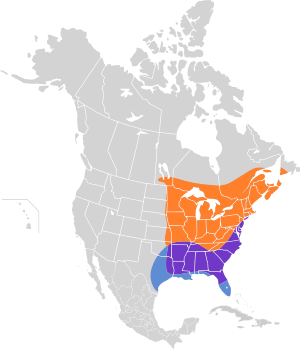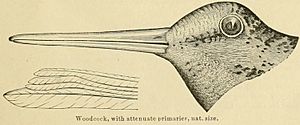American woodcock facts for kids
Quick facts for kids American woodcock |
|
|---|---|
 |
|
| Conservation status | |
| Scientific classification | |
| Genus: |
Scolopax
|
| Species: |
minor
|
 |
|
| Synonyms | |
|
Philohela minor |
|
The American woodcock (Scolopax minor) is a small shorebird found mostly in eastern North America. People sometimes call it the timberdoodle, bogsucker, or hokumpoke.
Woodcocks spend most of their time on the ground. They live in young forests and brushy areas. Their brown, black, and gray feathers help them blend in perfectly with their surroundings. This is called camouflage.
Male woodcocks perform amazing courtship flights. These flights make them a sign of spring in northern places. They are also a popular bird for hunters.
The American woodcock is the only type of woodcock in North America. Even though it's related to sandpipers, it mostly lives in dry, upland areas. Its population has been shrinking since the 1960s. This is mainly because their habitat is disappearing. Forests are growing older, and cities are expanding.
In 2008, experts made a plan to help woodcocks. They want to create and protect young forest habitats. This will help the woodcock population grow again.
Contents
- What does the American Woodcock look like?
- Where do American Woodcocks live?
- What do American Woodcocks eat?
- How do American Woodcocks migrate?
- How do American Woodcocks breed?
- Nesting and young
- What kind of habitats do American Woodcocks like?
- How is the American Woodcock population doing?
- Conservation efforts
- See also
What does the American Woodcock look like?
The American woodcock has a plump body and short legs. It has a large, round head and a long, straight bill. Adult woodcocks are about 10 to 12 inches (25 to 30 cm) long. They weigh about 5 to 8 ounces (140 to 225 g). Female woodcocks are usually bigger than males. Their long bill is about 2.5 to 2.75 inches (6.4 to 7 cm) long. Their wings can spread 16.5 to 18.9 inches (42 to 48 cm) wide.
Their feathers are a mix of browns, grays, and black. This helps them hide. Their chest and sides can be yellowish-white to tan. The back of their head is black with buff or reddish stripes. Their feet and toes are small and weak.
Woodcocks have very large eyes placed high on their head. They can see almost all around them, about 360 degrees horizontally. They can also see 180 degrees vertically. This wide view helps them spot danger.
The woodcock uses its long bill to find food in the soil. It mainly eats invertebrates, especially earthworms. A special bone and muscle lets the bird open the tip of its upper bill while it's in the ground. Both the underside of the upper bill and its long tongue are rough. This helps them grab slippery prey.
Where do American Woodcocks live?
Woodcocks live in forests and areas with a mix of forests, farms, and cities. They are found east of the 98th Meridian in North America. They have been seen as far north as Manitoba and east to Labrador. In winter, they fly south to the Gulf Coast states and Mexico.
Breeding areas
They breed from eastern Canada (like Nova Scotia) west to Manitoba. They also breed south to Virginia, North Carolina, Kentucky, and Missouri. Some woodcocks even breed in Florida and Texas. The species might be spreading further north and west.
Wintering areas
After flying south in autumn, most woodcocks spend winter in the Gulf Coast and southeastern Atlantic Coast states. Some stay as far north as Maryland and New Jersey. The main wintering areas are Louisiana, Mississippi, Alabama, and Georgia. Many woodcocks gather in northern Alabama during winter.
What do American Woodcocks eat?
Woodcocks mostly eat invertebrates. Their favorite food is earthworms. They like to feed in places where the soil is moist. They search for food by poking their bills into soft soil in thickets. They usually stay hidden while they eat.
They also eat other insects like larvae, snails, spiders, and beetles. They eat a small amount of plant food, mostly seeds. Woodcocks are crepuscular. This means they are most active at dawn and dusk.
How do American Woodcocks migrate?
Woodcocks fly at night when they migrate. They fly low, either alone or in small groups. They can fly between 16 to 28 miles per hour (26 to 45 kilometers per hour). However, the slowest flight speed ever recorded for a bird was a woodcock, at 5 miles per hour (8 kilometers per hour).
It is thought that woodcocks use landmarks like coastlines and river valleys to find their way. Their migrations in both autumn and spring are slow. They are not as fast as many other small birds.
In the North, woodcocks start moving south before ice and snow cover their food. Cold weather can cause many birds to fly south quickly in autumn. Most woodcocks start migrating in October. The biggest movement is from mid-October to early November. Most birds reach their winter homes by mid-December. They head north again in February. Most return to their northern breeding areas by mid-March to mid-April.
How do American Woodcocks breed?
In spring, male woodcocks find special open areas called "singing grounds." From these spots, they call and perform amazing display flights. They do this at dawn and dusk, and sometimes on moonlit nights.
The male's ground call is a short, buzzing sound like "peent." After calling, the male flies 50 to 100 yards (45 to 90 meters) into the air. He then flies down in a zigzag pattern, singing a chirping song. This high spiraling flight also makes a musical twittering sound. This sound comes from the air rushing through his outer wing feathers.
Males might keep doing these courtship flights for up to four months. They sometimes continue even after females have laid eggs and left the nest.
Female woodcocks, called hens, are attracted to these displays. A hen will fly in and land near a singing male. The male then tries to impress the female. He walks stiffly with his wings stretched up. He also bobs his head and bows. One male might mate with several females. The male woodcock does not help choose the nest site, hatch the eggs, or raise the young. Woodcocks are often one of the first ground-nesting birds to breed in northern areas.
Nesting and young
The hen builds a simple nest on the ground. She uses leaves and twigs. The nest is usually in brushy or young forest areas. It's often within 150 yards (137 meters) of a male's singing ground. Most hens lay four eggs, but sometimes one to three. The eggs hatch in 20 to 22 days.
The young woodcocks are covered in soft downy feathers. They are precocial, meaning they can leave the nest just a few hours after hatching. The mother bird keeps her young warm and feeds them. If they feel threatened, the young birds usually hide and stay very still. Their camouflage helps them avoid being seen. Some people have seen frightened young birds cling to their mother. The mother then flies away, carrying them to safety.
Woodcock chicks start looking for worms on their own a few days after hatching. They grow quickly. They can make short flights after two weeks. They can fly quite well at three weeks. They become independent after about five weeks.
American woodcocks can live up to 8 years in the wild.
What kind of habitats do American Woodcocks like?
American woodcocks live in wet thickets, moist woods, and brushy swamps. They like places with young forests and old farmland mixed with trees. In late summer, some woodcocks rest on the ground at night in large open areas. These spots have sparse, patchy plants.
- Courtship/Breeding habitats are open areas like roadsides and old fields. Males use these spots to call and perform their courtship flights in spring.
- Nesting habitats include thickets, shrubland, and young to middle-aged forests. These areas are mixed with open spaces.
- Feeding habitats have moist soil. They have many young trees like aspen and birch, or shrubs like alder. These trees are usually less than 20 years old.
- Roosting habitats are semi-open places with short, sparse plants. Examples include blueberry fields, pastures, and recently logged forest areas.
How is the American Woodcock population doing?
We don't know how many woodcocks lived in eastern North America before Europeans arrived. Early farming, with small farms and grazing animals, probably helped woodcock populations.
The woodcock population stayed high in the early and mid-1900s. This was when many family farms were left empty. Their fields and pastures grew into brushy areas. But in recent years, these brushy areas have become older forests. Woodcocks don't like older forests. Also, many areas have been covered by buildings and human development.
Because its population is declining, the American woodcock is considered a "species of greatest conservation need" in many states. This means that research and habitat creation efforts are happening to help boost their numbers.
Surveys show that the woodcock population has fallen by about 1.1% each year over the last forty years.
Conservation efforts
The IUCN does not consider the American woodcock globally threatened. It can handle some deforestation better than other woodcocks and snipes. As long as some sheltered woodlands remain for breeding, it can do well even in areas used for agriculture.
The American Woodcock Conservation Plan has regional action plans. These plans are linked to Bird Conservation Regions (BCRs). These are important biological areas recognized by the U.S. North American Bird Conservation Initiative. The Wildlife Management Institute (WMI) helps with regional habitat projects. These projects aim to increase the American woodcock's population. They do this by protecting, renewing, and creating habitat across the species' range.
Creating young-forest habitat for American woodcock helps many other animals. More than 50 other wildlife species need this type of habitat. These include common animals like white-tailed deer, snowshoe hare, moose, bobcat, wild turkey, and ruffed grouse. It also helps animals whose populations have also declined. These include the golden-winged warbler, whip-poor-will, willow flycatcher, indigo bunting, and New England cottontail.
- Choiniere, Joe (2006). Seasons of the Woodcock: The secret life of a woodland shorebird. Sanctuary 45(4): 3–5.
- Sepik, Greg F.; Owen, Roy & Coulter, Malcolm (1981). A Landowner's Guide to Woodcock Management in the Northeast, Misc. Report 253, Maine Agricultural Experiment Station, University of Maine.
See also
 In Spanish: Agachadiza americana para niños
In Spanish: Agachadiza americana para niños




